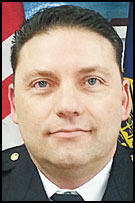Kevin Martinez: Documenting through body cameras
Body cameras in today’s society are critical and essential tools for law enforcement. Although this may seem logical across the board, implementation of a body camera program within a law enforcement agency does not happen without a number of serious considerations and complications. Two key issues include budgetary and personnel needs associated with the installation and management of a body camera system. It is important to mention that there can also be complications associated with technology and human error in addition to the inability of capturing events in their entirety with a 360 degree accounting from the onset that can cause undue scrutiny of an agency.
Without assigning blame, some police and citizen encounters across the country have led to frequent trust issues between law enforcement and community members. The Carlton Police Department, in conjunction with law enforcement agencies across the nation, continuously strives to evaluate current professional standards and practices, trainings and lessons learned in an effort to determine how to best achieve critical and necessary changes that minimize and reduce use of force encounters between police and citizens alike.
Although body cameras don’t eliminate use of force or confrontational encounters completely, they do provide to some degree the visual and audio documentation of an encounter. This documentation often only provides a limited visual of an encounter. This leaves what is not captured on video open to individual interpretation about what has happened prior to the video being activated, what is happening outside the view of the camera while it is on, and what happens after a video is turned off. Police agencies set policies and procedures, based on industry standards that dictate the utilization of body cameras in order to have the best accountable and transparent record of a citizen contact. This is still subject to question when human or mechanical errors contribute to an incident not being captured in its totality or not at all.
The use of body cameras by law enforcement agencies is still in its infancy stages with regard to technical, legal, confidentiality and public records issues at the federal and state levels. Ultimately body camera practices by police agencies remain a work in progress within the industry as well as within the public realm.
From my experience with the usage of our body camera program, there has been minimal opposition to being video or audio recorded during a contact. We have also witnessed a de-escalation mindset among Carlton police department personnel whether the body camera is activated or not. We have also or a de-escalation from citizens in varying degrees when it has been announced the contact is being video and audio recorded. Body cameras have played an integral role in providing our agency with a means to more accurately be able to review contacts associated with officer conduct complaints, enhance accuracy of written reports and assist in determining necessary training.
Law enforcement faces challenging times in which it is critical to demonstrate its effort to implement and train de-escalation techniques without compromising officer safety. Relative to this article, de-escalation is the concept of using various techniques by police to defuse an encounter with aggressive or hostile individuals in order to achieve a positive and productive outcome for everyone involved in a given situation and/or gain compliance from an individual or individuals without having to result in a use of force even though justified. The Carlton police department uses the concept that Time + Distance + Communication = De-Escalation. Efforts to de-escalate an encounter can also include reaching out to various resources, such as mental health professionals, to help calm or gain compliance from an individual.
As law enforcement officers, we come to work every day with the commitment and passion to enhance the livability and safety of our communities and all its citizens as our first objective. This also goes hand-in-hand with us going home to our families at the end of or our shift.
In an effort to document use of force encounters, protect officers and citizens alike, and minimize the potential for liability to the Carlton police department and city of Carlton, the implementation of body cameras in addition to in-car cameras and audio recorders has proven extremely beneficial. Despite all of the pros and cons associated with using body cameras, the Carlton Police Department has welcomed this technology.
As a state accredited law enforcement agency, the Carlton Police Department has committed itself to meeting or exceeding industry standards while at the same time evaluating and exploring new and innovative ways to improve its commitment, transparency and accountability to the citizens of our great community. We strive to overcome current daily challenges and anticipate what the future will hold and how to best prepare through continued self-evaluation and changes in policies and procedures as industry standards dictate. Utilization of this available technology enhances our overall ability to protect our police officers and citizens and better document critical situations.
Law enforcement and citizens have a responsibility to work together toward de-escalating encounters with each other in order to minimize deadly and traumatic outcomes for both sides. We all learn from past experiences in hopes that we collectively work toward a better and safer tomorrow, which can only happen with “Police & Community Together.”









Comments